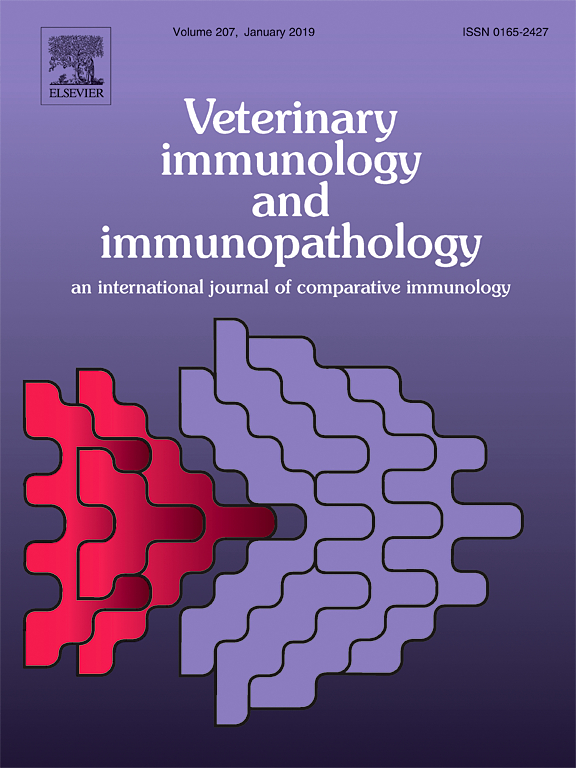Ver ítem
- xmlui.general.dspace_homeCentros Regionales y EEAsCentro Regional Buenos Aires SurEEA BalcarceArtículos científicosxmlui.ArtifactBrowser.ItemViewer.trail
- Inicio
- Centros Regionales y EEAs
- Centro Regional Buenos Aires Sur
- EEA Balcarce
- Artículos científicos
- Ver ítem
A Neospora caninum vaccine using recombinant proteins fails to prevent foetal infection in pregnant cattle after experimental intravenous challenge
Resumen
The aim of the present study was to evaluate the immunogenicity and protective efficacy of rNcSAG1, rNcHSP20 and rNcGRA7 recombinant proteins formulated with immune stimulating complexes (ISCOMs) in pregnant heifers against vertical transmission of Neospora caninum. Twelve pregnant heifers were divided into 3 groups of 4 heifers each, receiving different formulations before mating. Immunogens were administered twice subcutaneously: group A animals were
[ver mas...]
The aim of the present study was to evaluate the immunogenicity and protective efficacy of rNcSAG1, rNcHSP20 and rNcGRA7 recombinant proteins formulated with immune stimulating complexes (ISCOMs) in pregnant heifers against vertical transmission of Neospora caninum. Twelve pregnant heifers were divided into 3 groups of 4 heifers each, receiving different formulations before mating. Immunogens were administered twice subcutaneously: group A animals were inoculated with three recombinant proteins (rNcSAG1, rNcHSP20, rNcGRA7) formulated with ISCOMs; group B animals received ISCOM-MATRIX (without antigen) and group C received sterile phosphate-buffered saline (PBS) only. The recombinant proteins were expressed in Escherichia coli and purified nickel resin. All groups were intravenously challenged with the NC-1 strain of N. caninum at Day 70 of gestation and dams slaughtered at week 17 of the experiment. Heifers from group A developed specific antibodies against rNcSAG1, rNcHSP20 and rNcGRA7 prior to the challenge. Following immunization, an statistically significant increase of antibodies against rNcSAG1 and rNcHSP20 in all animals of group A was detected compared to animals in groups B and C at weeks 5, 13 and 16 (P < 0.001). Levels of antibodies against rNcGRA7 were statistical higher in group A animals when compared with groups B and C at weeks 5 and 16 (P > 0.001). There were no differences in IFN-γ production among the experimental groups at any time point (P > 0.05). Transplacental transmission was determined in all foetuses of groups A, B and C by Western blot, immunohistochemistry and nested PCR. This work showed that rNcSAG1, rNcHSP20 and rNcGRA7 proteins while immunogenic in cattle failed to prevent the foetal infection in pregnant cattle challenged at Day 70 of gestation.
[Cerrar]

Autor
Hecker, Yanina Paola;
Cóceres, Verónica Mabel;
Wilkowsky, Silvina Elizabeth;
Jaramillo Ortiz, Jose Manuel;
Morrell, Eleonora Lidia;
Verna, Andrea Elizabeth;
Ganuza, Agustina;
Cano, Dora Beatriz;
Lischinsky, Lilian Haydee;
Ángel, Sergio Oscar;
Zamorano, Patricia Ines;
Odeon, Anselmo Carlos;
Leunda, Maria Rosa;
Campero, Carlos Manuel;
Morein, Bror;
Moore, Prando Dadin;
Fuente
Veterinary Immunology and Immunopathology 162 (3–4) : 142-153 (December 2014)
Fecha
2014-12-15
Editorial
Elsevier
ISSN
0165-2427
Formato
pdf
Tipo de documento
artículo
Palabras Claves
Derechos de acceso
Restringido
 Excepto donde se diga explicitamente, este item se publica bajo la siguiente descripción: Creative Commons Attribution-NonCommercial-ShareAlike 2.5 Unported (CC BY-NC-SA 2.5)
Excepto donde se diga explicitamente, este item se publica bajo la siguiente descripción: Creative Commons Attribution-NonCommercial-ShareAlike 2.5 Unported (CC BY-NC-SA 2.5)

